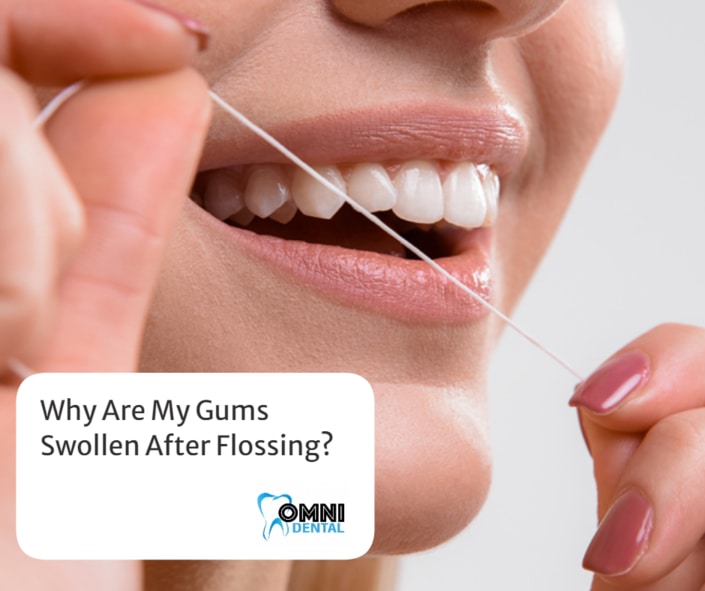Gum Swollen After Flossing

The sensation of swollen gums after flossing can be quite unsettling, leaving many to wonder if they’ve done more harm than good in their pursuit of oral hygiene. To understand why this happens and what it means for your oral health, let’s dive into the world of dental care and explore the intricacies of gum health.
The Importance of Flossing
Flossing is a critical component of any oral hygiene routine. It helps remove food particles and plaque from between the teeth and under the gumline, areas that toothbrushes often can’t reach. Plaque, a sticky film of bacteria, can lead to gum disease if not removed regularly. The early stage of gum disease is known as gingivitis, characterized by inflammation of the gums. If left untreated, it can progress to periodontitis, a more serious infection that damages the soft tissue and, without treatment, can destroy the bone that supports your teeth.
Why Gums Become Swollen After Flossing
Swollen gums after flossing can be due to several reasons:
Gingivitis: If you have gingivitis, your gums are already inflamed. Flossing can sometimes irritate the gums further, leading to swelling, especially if you’re new to flossing or haven’t flossed in a while.
Aggressive Flossing: Being too aggressive with the floss can damage the gum tissue, leading to swelling and sometimes even bleeding. This is especially true if you’re using a sawing motion or pressing too hard against the gums.
Poor Flossing Technique: The way you floss can also impact your gum health. If you’re not using the correct technique, you might end up pushing bacteria and debris further into the gums, causing irritation.
Underlying Conditions: Sometimes, swollen gums after flossing can be a sign of an underlying condition that needs medical attention. For instance, if you have a suppressed immune system or certain vitamin deficiencies, your gums might be more prone to swelling.
New to Flossing: If you’re new to flossing, your gums might be sensitive simply because they’re not used to the process. This sensitivity can lead to swelling, especially in the initial stages of incorporating flossing into your routine.
How to Prevent or Reduce Swollen Gums After Flossing
To prevent or reduce swollen gums after flossing, consider the following tips:
Gentle Technique: Use a gentle, sliding motion when flossing. Curve the floss around the base of each tooth in a “C” shape, making sure to go beneath the gumline but being careful not to snap or force the floss.
Regular Flossing: The more you floss, the less likely your gums are to become irritated by the process. Aim to floss at least once a day.
Proper Oral Hygiene: Combine flossing with regular brushing and mouthwash use for comprehensive oral hygiene.
Soft Floss or Interdental Brushes: If traditional flossing proves too irritating, consider using a soft floss or interdental brushes designed for sensitive teeth and gums.
Professional Cleaning: Regular dental check-ups can help identify any issues early on, including plaque buildup and gingivitis, reducing the risk of swollen gums.
When to Seek Professional Help
While some swelling after flossing can be normal, especially if you’re just starting out, there are instances where you should seek professional help:
Persistent Swelling or Pain: If your gums remain swollen or painful for more than a few days after flossing.
Bleeding: If your gums bleed excessively while flossing or if the bleeding doesn’t stop after a few days of gentle flossing.
Recurring Infections: If you experience recurring gum infections or abscesses.
Systemic Symptoms: If you notice systemic symptoms like fever, swelling of the face, or difficulty swallowing, which could indicate a more serious infection.
Conclusion
Swollen gums after flossing can be a temporary and manageable issue with the right approach to oral hygiene and care. By understanding the reasons behind this swelling and adopting gentle, regular flossing techniques, you can reduce irritation and promote healthier gums. Remember, oral health is a journey, and with consistent effort and the right strategies, you can prevent many common issues that lead to swollen gums and other more serious conditions.
Is it normal for gums to bleed after flossing?
+Bleeding gums can be a sign of gingivitis or poor flossing technique. If you notice bleeding, adjust your flossing technique to be gentler and ensure you're flossing regularly. However, if the bleeding persists, it's a good idea to consult a dentist.
How often should I floss?
+It's recommended to floss at least once a day, preferably before brushing your teeth at night. This helps remove any food particles and plaque that may have accumulated during the day.
What is the best type of floss to use?
+The best type of floss for you can depend on your specific needs. Unwaxed floss is a good all-around choice, but if you have tightly spaced teeth, you might prefer waxed floss or dental tape. For sensitive gums, consider a soft or gentler floss.
By combining good flossing habits with regular dental check-ups and a comprehensive oral hygiene routine, you can keep your gums healthy, reduce the risk of swelling, and enjoy a brighter, healthier smile.